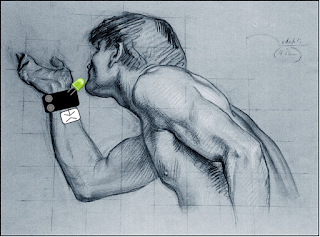Wearable Polygraph
 Today I am going to outline the plan for an upcoming project.
Today I am going to outline the plan for an upcoming project. Concept:
By measuring numerous sources of information on the human body I intend to evaluate the information that is made available involuntarily when someone speaks. By using running averages, statistical modeling, or a neural network along I will try to go beyond current work in Human Activity Recognition to detect variations from "Normal" responses.This task is my attempt to make a general purpose wearable polygraph machine. In this post I will demonstrate a more full explanation of the concept, outline the technical requirements that this will involve, give some background on expected audience and environment, and finally go over the materials that I plan to use to successfully implement this idea.
Requirements:
To accomplish the goal of this project I will need to monitor a multitude of body sensor data in real time:- Breathing rate
- Pulse (heart rate)
- Muscle Activation (involuntary nervous response)
- Perspiration (skin conductivity)
- Sound
Corroborating all of this sensor data in a way that is rapidly relevant is going to be a challenge as the rates, and relevance may vary. This will certainly take some tuning.
In addition to these data sources I would like the device to be comfortably wearable and minimally intrusive.
 Challenges:
Challenges:
1. Many of the challenges that I anticipate involve correlating information in real time from disparate sources which may read at different rates. Handling this in an elegant way will be complicated, but I am excited about the possible expressiveness that may be available.2. An Arduino has a limited amount of computing power, storage space -- this project may challenge both of these limitations as I attempt to model the different sources of information.
3. Finally there will be no labeled data for the custom sensors that I am intending to use. Therefor I will have to create a data-set to train on if I intend to use neural network techniques. Never the less I intend to try, possibly using online learning as I move through development.
Audience & Environment:
To define an audience and an operating environment I will provide a few examples of places that I expect this project to be applicable. I hope to make the project unisex and wearable over long periods of time.1. A politician giving a speech can last two to three hours. I think that this is an excellent possible application. Adding subtext inherent to the speakers involuntary response would be extremely informative for the general public.
 2. A performance artist today who wants to broadcast their voluntary and involuntary responses could wear this device when interacting in public or private.
2. A performance artist today who wants to broadcast their voluntary and involuntary responses could wear this device when interacting in public or private.If possible I would like the device to have the longevity of lasting all day. The device is not driving high power actuators so it shouldn't draw too much power.
3. A research study that needs to measure someones engagement with their product could use this during interviews to glean extra information that the participant may not even be aware of.
4. A slightly modified version of the device could be integrated with a mobile phone to give information about immediate nervous response to specific applications. You could imagine a dating app that checks whether you are interested without even realizing it.
 Materials:
Materials:
To accomplish this project I plan to use the following materials.Electronic Components:
- Adafruit flora - Central processing
- Lithium Polymer battery -- longer lasting & rechargeable power source.
- Heart Rate sensor - Polar brand set made available through adafruit. alternatively this senor.
- Galvanic Skin Response sensor - seedstudio provides a likely candidate.
- Muscle activation - Muscle twitch to indicate involuntary nervous responses.
- Sensitive temperature sensor - measuring the changes in body temperature provides information about breathing rate.
- RGB LED Indicator - demonstrate to the world the discovered information.
Garment Components:
- Wearable Strap - many of these sensors must be tightly held against the skin an adjustable elastic strap can do this comfortably. This could use the strap from the Adafruit Polar heart rate kit, or one made at home. This will sit either against the wrist or the chest.
- Electronics Housing - 3d printed hard case or soft sleeve
- Conductive Thread
- Glove - measuring GSR may require access to fingers.
If the project is progressing well during development there are other sources of information that I would like to incorporate. Doing so would create new design and / or data processing challenges, but would allow for more expressive detection.
Going beyond:
- EEG Sensor - Measuring neural activation could give extra insight however I don't intend to use it unless the project is moving along faster than expected.
- Blood pressure Sensor - while very informative this would be difficult to build into a comfortable garment. Though it could be done.
Watch out for more polygraph science and project updates in the coming weeks!





Comments
Post a Comment